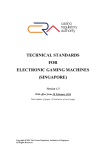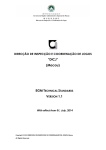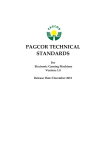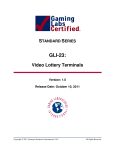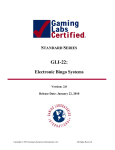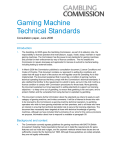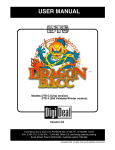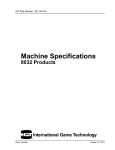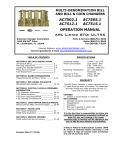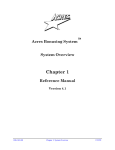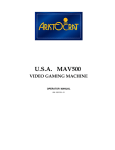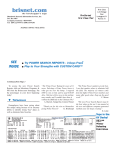Download technical standards for electronic gaming machines
Transcript
TECHNICAL STANDARDS FOR ELECTRONIC GAMING MACHINES (SINGAPORE) Version 1.3 With effect from 24 March 2012 Total number of pages: 31 (inclusive of cover page) Copyright 2012 The Casino Regulatory Authority of Singapore. All Rights Reserved. Technical Standards for Electronic Gaming Machines (Singapore) No part of this document shall be reproduced, in any form or by means, without permission in writing from the Casino Regulatory Authority of Singapore (the “Authority”). Whilst every effort has been made to ensure that the information contained in this document is accurate as at the date of issue, the Authority makes no warranty or representation whatsoever with regards to the information in this document. The Authority assumes no responsibility or liability for any consequences (financial or otherwise) suffered directly or indirectly by persons who have entered into commercial activities upon reliance on any information in this document. The information in this document is subject to change from time to time to adapt to the continual development and evolution of the gaming industry in Singapore. The Authority reserves the right to change its policies and to amend, modify or supplement any information in this document This document does not in any way bind the Authority to grant any approval for or exemption from any matter for which approval is required under any written law in Singapore. This document shall not affect any regulatory requirements of any other competent authority in Singapore. Persons who may be in doubt about how the information in this document may affect them or their commercial activities are advised to seek independent legal advice or any other professional advice they may deem appropriate. Official Release Version 1.3 Page 2 of 31 Technical Standards for Electronic Gaming Machines (Singapore) TABLE OF CONTENTS PREFACE ........................................................................................................ 5 1. INTRODUCTION ................................................................................. 6 1.1 Purpose................................................................................................... 6 1.2 Scope ..................................................................................................... 6 1.3 Terminology ........................................................................................... 6 1.4 Definition of Terms ................................................................................. 7 1.5 Testing ................................................................................................... 9 1.6 Consistency of Interpretation .................................................................... 9 2. HARDWARE – MACHINE REQUIREMENTS ................................... 10 2.1 Cabinetry .............................................................................................. 10 2.2 Cash Input System ................................................................................. 11 2.3 Cash Output System ............................................................................... 12 2.4 Printed Circuit Boards (PCBs) ................................................................ 13 2.5 Printers ................................................................................................. 13 2.6 Read Only Memory (ROM) .................................................................... 14 2.7 Critical Memory .................................................................................... 14 2.8 Program Storage Devices........................................................................ 14 2.9 Communication with peripherals ............................................................. 15 2.10 Environmental Interference Effects .......................................................... 15 2.11 Tilt Conditions ...................................................................................... 16 3. SOFTWARE REQUIREMENTS ......................................................... 18 3.1 Control Program Requirements ............................................................... 18 3.2 Soft Meters ........................................................................................... 18 3.3 Payout Percentages and Odds .................................................................. 23 3.4 Random Number Generator (RNG) ......................................................... 24 3.5 Program Interruption and Resumption ...................................................... 25 3.6 Bonus or Extended Play Features ............................................................ 26 3.7 Last Game Recall .................................................................................. 26 3.8 Independent Software Verification .......................................................... 27 3.9 Progressive Jackpot Link ........................................................................ 27 4. ARTWORK REQUIREMENTS........................................................... 28 4.1 Game Instructions .................................................................................. 28 4.2 Pay Tables ............................................................................................ 28 Official Release Version 1.3 Page 3 of 31 Technical Standards for Electronic Gaming Machines (Singapore) 4.3 Player Information Display ..................................................................... 28 5. EXTERNAL COMMUNICATIONS .................................................... 30 5.1 Communications .................................................................................... 30 6. OPERATIONAL REQUIREMENTS ................................................... 31 6.1 Artwork and Display .............................................................................. 31 LIST OF FIGURES Figure 1: Sample PID Page Layout ...........................................................................29 Official Release Version 1.3 Page 4 of 31 Technical Standards for Electronic Gaming Machines (Singapore) Preface The purpose of this document is to establish the requirements for the design and operation of gaming machines within the jurisdiction of Singapore and to guide testing and certification bodies on the areas for technical compliance for the gaming machines. The intent of this document is to ensure that gaming on electronic gaming machines occur in a manner that is:a. Honest; b. Secure; c. Reliable; and d. Auditable. It is not the intent of this document to:a. Mandate a single solution or method to realise an objective; b. Limit technology application to gaming equipment; c. Limit creativity and variety of choice; d. Preclude research and development into new technologies equipment or innovative ideas. As far as possible, this document specifies what the minimum technical requirements for electronic gaming machines are instead of how the requirements should be met; nor try to mandate a particular solution or method as the means to realise the requirements. The Casino Regulatory Authority of Singapore (the “Authority”) is the regulatory authority that supervises and regulates the activities of casinos in Singapore. Casino operators are required to be licensed by law and must ensure that their gaming machines deployed on the casino floor comply with these technical standards. These technical standards are supplementary to and are not intended to derogate from any provisions in the Casino Control Act (Cap. 33A) and its subsidiary legislations. In the event of any consistency, the provisions in the Casino Control Act (Cap. 33A) and its subsidiary legislations shall apply. These technical standards are subject to on-going review, and where necessary or deemed appropriate, the Authority reserves the right to unilaterally amend or re-issue this document without notice. Comments on this document can be forwarded to:Casino Regulatory Authority of Singapore Gaming Technology and ICT Systems Division 460 Alexandra Road, #12-01 Singapore 119963 Website: http://www.cra.gov.sg Official Release Version 1.3 Page 5 of 31 Technical Standards for Electronic Gaming Machines (Singapore) 1. INTRODUCTION 1.1 Purpose 1.1.1 The purpose of this technical standard is to:a. Create a standard that would ensure that the operation of gaming machines in Casinos under Singapore’s jurisdiction are secure, reliable, auditable and operated correctly; b. Eliminate subjective criteria in evaluating and certifying gaming machine operation; c. Construct a standard that is technology neutral wherever feasible; and d. Construct a standard that does not specify or approve any particular method or algorithm. The intent being to allow a wide range of methods to be used to conform to the standards as long as the methods are secure, reliable and consistent with the technology best practices of the day. 1.2 Scope 1.2.1 The scope of this technical standard covers the minimum standard and security safeguards required in the operation of the gaming machine so that security, reliability and integrity of the gaming machine are achieved. 1.2.2 This technical standard does not cover requirements that are not related to gaming (such as health and safety). 1.3 Terminology 1.3.1 The following terminology used in this document is to be interpreted as follows:a. Shall: The guideline defined is a mandatory requirement, and therefore must be complied with; b. Should: The guideline defined is a recommended requirement. Noncompliance shall be documented and approved by the management. Where appropriate, compensating controls shall be implemented; and c. May: The guideline defined is an optional requirement. The implementation of this guideline is determined by the operator’s environmental requirements. Official Release Version 1.3 Page 6 of 31 Technical Standards for Electronic Gaming Machines (Singapore) 1.4 Definition of Terms Authority/ The CRA The Casino Regulatory Authority of Singapore Alterable media Any form of storage device that allows the modification of the programs or data on the device during the normal operation of the gaming machine. This does not include devices typically considered to be alterable but through either software or hardware means been rendered unalterable. Bonus Game An additional function not part of the base game which allows extra credits to be won. They may take the form of free games and/or extended play screen features. Cashless Wagering System A Cashless Wagering System (CWS) is characterised as a host system whereby a player maintains an electronic wagering account on the cashless wagering system host database. A casino will provide the player a secure means of accessing the wagering account on the gaming machines. This is not limited to the issuing of a unique magnetic card and a Personal Identification Number (PIN) in conjunction with the wagering account on the CWS database. Funds may be added to this player’s wagering account via a cashier station or any supporting kiosk (through the insertion of coins and bills). The account value can be reduced either through debit transactions, in smaller amounts at a gaming machine or by cashing out at a cashier's cage. Once play is completed the player may have the option to move some of the credits back to the player's account or cash out some credits. Conventional ROM Device Device incapable of being altered while installed in a gaming machine and may contain executable programs or data that are directly addressable by a processor. Credit meter Gaming machine indicator that displays the number of denominational credits or monetary value available to a patron for wagering. Critical Memory Memory locations storing information that is considered vital for the continued proper operation of the gaming machine. Disruption Any form of disoperation, component failure or interference to the equipment. Electrostatic Interference (ESI) Physical property of being able to create electronic interference to a device by either discharging static electricity onto the surface of the unit (such as from a user) or via a mains power or communication cable (from lightning for example). Official Release Version 1.3 Page 7 of 31 Technical Standards for Electronic Gaming Machines (Singapore) Electromagnetic Interference (EMI) Physical characteristic of an electronic device to emit electronic noise either into free air, onto the mains power lines, or communication cables. EPROM Erasable Programmable Read Only Memory – non-volatile storage hardware, see ROM. Inappropriate coin-in Legal coin or token of the correct denomination which has been accepted by a gaming machine after the machine has already accepted its maximum number of coins or when the machine is in a state which normally rejects additional coins. Logic Area The separately locked area within a gaming machine that houses the electronic components that would significantly influence the gaming outcome. Meter A non-volatile variable, storing gaming machine audit and other information. Player Interface Module An unit in the gaming machine that may contain different types of peripheral devices such as card readers, key pads, displays and biometric input mechanisms used for advertisements and electronic transactions. PLD Programmable Logic Device – electronic component in digital circuits. Promotional Coupon A printed wagering instrument that has a fixed dollar wagering value that can only be used to acquire non-cashable credits. Random Access Memory (RAM) Electronic component used for computer workspace and storage of volatile information in a gaming machine. RAM Clear Process that is used to reset the memory of a gaming machine which configures the gaming machine into a “as new” state. Random Number Generator (RNG) Hardware, software or combination device for generating number values that exhibits characteristics of randomness. Read Only Memory (ROM) Electronic component used for storage of non-volatile information in a gaming machine. This includes programmable ROM and Erasable Programmable ROM. Residual Credit Removal Play A function of residual credit removal (which allows the player to remove residual credits from the gaming machine), in which the player has a chance of rounding up the remaining residual credits to the token value. Official Release Version 1.3 Page 8 of 31 Technical Standards for Electronic Gaming Machines (Singapore) Tilt Condition Programmed error state for a gaming machine. A tilt condition has occurred when the device detects an internal error, malfunction, attempted cheating or other specific events (see Section 2.12) and it disallows further play until the event is resolved. TITO (Ticket In – Ticket Out) A TITO System is a component of the Slot Management System (SMS), which issues and validates unique identifying number to vouchers printed out by ticket printers in gaming machines. TITO Voucher Vouchers printed out by ticket printers in gaming machines linked to a TITO System. The vouchers can either be redeemed for cash, or inserted for play into other gaming machines that support this mechanism. 1.5 Testing 1.5.1 Testing of gaming machines and equipment by recognised testing laboratories shall be aimed at determining compliance with the technical requirements provided in this document. Areas of non-compliance shall be reported in the test/certification report. Where, in the opinion of the testing/certification laboratory, the technical requirements spelt out in this document are insufficient, inappropriate or not pertinent to the design of the subject gaming machine or equipment, the laboratory shall seek direction and further clarification from the Authority before proceeding to testing/certification. 1.6 Consistency of Interpretation 1.6.1 The Casino Regulatory Authority (CRA) of Singapore recognises that the technical standards may be subject to different interpretations by gaming machine manufacturers, casino operators and testing/certification laboratories. As such, any feedback where different interpretations may be applied to the technical standards provided in this document should be directed to the CRA for clarification when it arises. Official Release Version 1.3 Page 9 of 31 Technical Standards for Electronic Gaming Machines (Singapore) 2. HARDWARE – MACHINE REQUIREMENTS This section describes the physical aspects of a gaming machine, its components and its inner workings. The objective is to provide design standards for manufacturers to ensure that all compliant electronic gaming machine platforms can be operated in an honest, secure, reliable and auditable manner. 2.1 Cabinetry Cabinet Identification 2.1.1 A gaming machine shall have an identification badge that is permanently affixed to the exterior of the cabinet by the manufacturer and shall include, at minimum, the following information:a. The name of the manufacturer; b. A unique serial number; c. The gaming machine model number; and d. The date of manufacture. Cabinet Security 2.1.2 The gaming machine (inclusive of its logic area) shall be robust enough to resist forced illegal entry and shall retain evidence of any sign of illegal entry until properly cleared before the initiation of a new play. 2.1.3 The gaming machine shall be designed so that power and data cables into and out of the gaming machine can be routed so that they are not accessible to the general public. Logic Area 2.1.4 The logic area shall be designed as a separately locked up area that houses the following electronic components that would significantly influence the operation of the gaming machine:a. Main circuit board that houses the CPUs; and b. Any program storage devices, as described in Section 2.8. 2.1.5 Logic areas shall be designed with : - 1 2.1.5.1. the provision for a physical tamper evident seal 1, which must be broken on entrance of or before performing any changes to the logic area; and 2.1.5.2. the provision of an auto-triggered alarm to its connected slots management system intended for upon any openings of the logic area. Method of sealing shall be separately approved by the Authority. Official Release Version 1.3 Page 10 of 31 Technical Standards for Electronic Gaming Machines (Singapore) 2.1.6 All RAM clear activities shall not be allowed without accessing the logic area. 2.2 Cash Input System Coin Acceptor Devices 2.2.1 Coin acceptor devices, if present, shall accept only approved coins of appropriate legal tender and be protected against vandalism, abuse or fraudulent activity. 2.2.2 The coin acceptor devices shall be designed to meet the following requirements:a. Ability to accept or reject a coin on the basis of metal composition, mass, composite makeup or equivalent security; b. Ability to indicate accurately each valid coin inserted to the gaming machine controlling software and to return all inappropriate coin-ins back to the player; and c. Ability to guard against known cheating methods such as slugging (use of counterfeit coins), stringing (coin pullback), rapidly fed/piggy backed coins, and the insertion of foreign objects or other manipulation. Banknote Acceptor Devices 2.2.3 The banknote acceptor device shall be an electronic device that is configured to ensure that the device only accepts valid legal tender bills and reject all others with high accuracy and provide a mechanism to enable the gaming machine software to interpret and act appropriately on a valid or invalid input. 2.2.4 The banknote acceptor device shall be designed to protect against vandalism, abuse or other fraudulent activity. 2.2.5 All accepted banknotes shall be deposited into a secure banknote storage area in the gaming machine. Rejected or invalid notes shall be returned to the player. 2.2.5A The banknote acceptor device shall have mechanisms to allow software to interpret and act upon the following conditions:a. Stacker full; b. Bill jams; c. Stacker removed; and d. Any other applicable malfunction not specified above. Cashless In 2.2.6 Gaming machines shall make use of a proven, secure and reliable method when providing a cashless wagering feature to add credits to the gaming machines from an account (e.g. with the use of smart card, magnetic strip card). Official Release Version 1.3 Page 11 of 31 Technical Standards for Electronic Gaming Machines (Singapore) 2.2.7 The method and the cashless wagering feature shall comply with the Authority’s “Technical Standards for Cashless Wagering System”. Credit Meter Limit 2.2.8 Gaming machines shall allow a credit meter limit to be set such that in the event that the limit is reached, the gaming machine will refuse to accept any more coins, banknotes or cashless in unless a wager is made or play initiated. 2.3 Cash Output System Coin Hoppers 2.3.1 The coin hopper, if fitted in a gaming machine that is operated using coins, shall be located within the gaming machine. 2.3.2 The coin hopper shall be designed to be resistant to manipulation by a light source or any foreign object. 2.3.3 The gaming machine shall be able to detect the following hopper conditions in all game states:a. Hopper Empty; b. Hopper Jam; c. Hopper Full; and d. Extra Coin Paid / Hopper Runaway (one or more unintended coins exiting the hopper). 2.3.4 All coins paid from the hopper mechanism shall be properly accounted for by the gaming machine including those paid out as extra coins during a hopper malfunction. Cashless Out 2.3.5 Gaming machines shall use a proven, reliable and secure method when providing a cashless wagering feature to transfer money in the form of credits out of the gaming machines to an account (e.g. with use of smart card, magnetic strip card). 2.3.5A The method and the cashless wagering feature shall comply with the Authority’s “Technical Standards for Cashless Wagering System”. 2.3.6 Gaming machines shall have the capacity to display a complete transaction history for the most recent thirty-five (35) transactions with a cashless wagering system. Retention of transaction history for additional prior transactions would be strongly encouraged. Voucher/Coupon Printing 2.3.7 The issuance of vouchers/coupons for making payments, if implemented, shall include, at minimum, the following information:- Official Release Version 1.3 Page 12 of 31 Technical Standards for Electronic Gaming Machines (Singapore) a. Casino name; b. Unique gaming machine identification number; c. Current date and time of issuance (in 24-hour format); d. Value of vouchers/coupons in dollars and cents; e. Unique identifying number of the voucher/coupon; f. Status of voucher (i.e. valid, unredeemed, pending, void, invalid, redemption in progress, redeemed, etc); and g. Number of days before voucher/coupon expires. Cash-Out Limit 2.3.8 Gaming machines shall allow a cash-out limit to be set such that playerinitiated cash-outs beyond the limit will not be paid out by the machine, but instead require intervention by an attendant. 2.4 Printed Circuit Boards (PCBs) 2.4.1 Each customised PCB in a gaming machine shall be identifiable by a name (or number) and revision level that is displayed on the board. 2.4.2 The circuit board assemblies, used in gaming machines, shall conform functionally to the documentation of the PCBs that were submitted to the recognised testing laboratory. 2.4.3 All patch wires and track cuts for any customised PCB in a gaming machine shall be documented in the relevant service manual/bulletin and submitted to the recognised testing laboratory. 2.4.4 All switches and jumpers shall be fully documented for testing by the recognised testing laboratory. 2.4.5 Switches or jumpers that have the potential to affect the security, integrity or the game result (e.g. percent return) of the gaming machine shall not be permitted. 2.5 Printers 2.5.1 Printers shall be mounted inside the gaming machine. 2.5.2 The printer shall have mechanisms to allow software to interpret and act upon the following conditions:a. Out of paper / Paper low; b. Printer jam/failure (including out of ink/toner errors if applicable); and c. Disconnected. Official Release Version 1.3 Page 13 of 31 Technical Standards for Electronic Gaming Machines (Singapore) 2.6 Read Only Memory (ROM) 2.6.1 All Conventional Read Only Memory (ROM) devices and other programmable logic elements shall be clearly marked with sufficient information to identify the software and revision level of the information stored in the devices. 2.6.2 All Conventional ROM devices (and PLDs) that have erasure windows shall be fitted with covers over their erasure windows. 2.6.3 Gaming machines with control programs or other security programs residing in Conventional ROM devices such as EPROMs shall have the unused portions of the memory device that contains the program set to zero. 2.6.4 Control programs residing in one or more Conventional ROM Devices shall employ a mechanism to verify the integrity of the control programs and data. 2.7 Critical Memory 2.7.1 The following requirements shall be met for critical memory in gaming machines:a. Critical memory data storage shall be capable of reliably preserving its memory contents for at least thirty (30) days with the mains power switched off. A rechargeable or non-rechargeable backup power source may be used to meet this requirement; b. A proven and reliable mechanism shall be implemented to check for any corruption of critical memory locations used for crucial gaming machine functions. This shall include information pertaining to the play and final outcome of the most recent game, the nine (9) games prior to the most recent game, random number generator outcome, credits available for play, and any other error states. Detection of any corruption that cannot be corrected shall be deemed to be a game malfunction; c. Clearing memory shall only be undertaken by accessing the logic area in which it is housed; and d. In a RAM clear, the game program shall execute a routine, which sets each and every bit in RAM to the default state. For games that allow for partial RAM clears, the methodology shall be highly accurate and shall validate the un-cleared portions of RAM. 2.8 Program Storage Devices 2.8.1 A program storage device (e.g. CD-ROM, flash memory devices or alternate storage medium) shall only contain the program files that operate the game and shall be authenticated upon power up and at the first time the program files are loaded for use. 2.8.2 A proven and robust mechanism shall be implemented to internally authenticate that the program files and/or support files had not been corrupted or altered prior to use/loading. The mechanism shall prevent further play of the gaming machine if unexpected data or inconsistencies are found. Official Release Version 1.3 Page 14 of 31 Technical Standards for Electronic Gaming Machines (Singapore) 2.8.3 Write protection shall be employed on the program storage device where applicable. 2.8.4 If the gaming machine is not intended to be used in a client-server system, the program storage device shall not be re-written or re-programmed, unless the process of re-writing and re-programming entails accessing and unsealing (if sealed) of the logic area. 2.9 Communication with peripherals 2.9.1 Communication ports shall be clearly labeled and located within the gaming machine to prevent unauthorised access to the ports or cable connectors. 2.9.2 The communication protocol shall also ensure that erroneous data or signals would not adversely affect the operation of the gaming machine. 2.10 Environmental Interference Effects Electromagnetic Interference 2.10.1 Gaming machines shall not create electronic noise that affect the integrity of neighboring machines or associated equipment. Electrostatic Interference 2.10.2 Gaming machines shall exhibit total immunity to human body electrostatic discharges on all areas exposed to player contact. 2.10.3 Gaming machines may exhibit temporary disruption when subjected to a significant electro-static discharge greater than human body discharge, but they shall exhibit a capacity to recover and complete any interrupted play without loss or corruption of any control or data information associated with the gaming machine. The tests shall be conducted with a severity level of a minimum of 20 kV air discharge. Radio Frequency Interference 2.10.4 Gaming machines shall not divert from normal operation by the application of RFI at a frequency range from 27 to 1000 MHz with field strength of three (3) volts per metre. Liquid Spills 2.10.5 Liquid spills applied to the outside of a gaming machine shall not affect the normal operation of the machine or the integrity of the material or information stored inside the cabinet. If liquids are spilled into a coin acceptor or bill acceptor, any resulting malfunction shall result in the acceptor rejecting all inputs or generating an error condition. Official Release Version 1.3 Page 15 of 31 Technical Standards for Electronic Gaming Machines (Singapore) 2.11 Tilt Conditions 2.11.1 Gaming machines shall detect and display the following conditions during idle states or game play. The following conditions may be automatically cleared by the gaming machine upon completion of a new play sequence and also communicated to a slot management system if applicable:a. Power reset; b. Door open (including bill acceptor); c. Door just closed; and d. Inappropriate coin-in if the inappropriate coin(s) in are not returned to the player. 2.11.2 Gaming machines shall be capable of detecting and displaying the following conditions that shall disable the game play and shall only be cleared by an attendant and also communicated to a slot management system if applicable:a. Coin-in error (e.g. coin jam, reverse coin-in, etc.); b. Coin-out error (e.g. coin jam, extra coin paid out, etc.); c. Hopper empty or timed-out (hopper failed to make payment); d. Hopper Runaway; e. Banknote-in jam; f. Low RAM battery for batteries external to the RAM itself or low power source; g. Uncorrectable RAM error (RAM defective or corrupted); h. Print failure, if the gaming machine has no other means to make a payout, a replacement voucher may be printed once the failure condition has been cleared; i. Printer mechanism paper jam. A paper jam condition shall be monitored at all times during the print process; j. Printer mechanism paper out; k. Presentation error; l. Program error (Defective program storage media); m. Reel spin error of any type including a mis-index condition for mechanical reels. The specific reel number shall be identified as part of the error condition and microprocessor controlled reels, if applicable, shall be monitored to detect malfunctions such as a reel which is jammed, or is not spinning freely, or any attempt to manipulate their final resting positions; and n. Removal of control program storage media. 2.11.3 A description of tilt codes and their meanings shall be affixed inside the gaming machine unless the displayed codes are self-explanatory. Official Release Version 1.3 Page 16 of 31 Technical Standards for Electronic Gaming Machines (Singapore) 2.11.4 Gaming machines shall be capable of sustaining prolonged 2 period of game plays without memory leaks. 2 Prolonged is defined as the period of time in between consecutive preventive maintenance as recommended by the gaming machine manufacturer. Official Release Version 1.3 Page 17 of 31 Technical Standards for Electronic Gaming Machines (Singapore) 3. SOFTWARE REQUIREMENTS This section describes the software requirements so that the software functions as intended and is honest and reliable to the player. It establishes the minimum standards of functionality so that all compliant electronic gaming machine platforms would be secure, reliable, auditable and operate according to their specification. 3.1 Control Program Requirements 3.1.1 Gaming machine control programs (software that operates the gaming machine’s functions) shall be authenticated against possible corruption caused by the failure of the program storage medium and all critical game functions during each power-up cycle. The methodology shall detect 99.99 percent of all possible failures. 3.1.2 Any program component of the authentication or initialisation mechanism shall be stored on a non-modifiable physical storage device such as a Conventional ROM Device and shall be capable of being verified. 3.1.3 The control programs shall utilize an integrity check with a secured hashing method of at least 128 bits such as MD5. 3.2 Soft Meters 3.2.1 All gaming machines shall be equipped with soft meters (electronic digital storage meters) of at least ten (10) digits capable of recording and displaying the required information listed in this section where applicable to the gaming machine. 3.2.2 All soft meters shall be updated upon the occurrence of the particular event the meter is monitoring. All meters shall be added to except for coin handling meters (i.e. Coin In and Coin Out meters) which may be added to or incremented if preferred. The term “added to” provides for a fetch of the current value from memory, conduct of an arithmetic add operation and storage back in memory. 3.2.3 These meters, listed below, shall accumulate the following information in Singapore currency, dollars and cents. Gaming machines configured for multidenomination play shall display the required information in Singapore currency, dollars and cents. Official Release Version 1.3 Page 18 of 31 Technical Standards for Electronic Gaming Machines (Singapore) Meter Name Definition a) Coin In The machine shall have a meter specifically labeled “Coin In” that accumulates the total value of all wagers, whether the wagered amount results from the insertion of coins, tokens, currency, vouchers, coupon, deduction from a credit meter or any other means. This meter shall:a. Not include subsequent wagers of intermediate winnings accumulated during game play sequence such as those acquired from “double up” games; b. For multi-game and multi-denomination/multi-game gaming machines, provide the information necessary, on a per pay table basis, to calculate a weighted average theoretical payback percentage; and c. For gaming machines which are considered slot machines and which contain pay tables with a difference in theoretical payback percentage which exceeds 4 percent between wager categories, maintain and display coin in meters and the associated theoretical payback percentage, for each wager category with a different theoretical payback percentage, and calculate a weighted average theoretical payback percentage for that paytable. b) Coin Out The machine shall have a meter specifically labeled “Coin Out” that accumulates the total value of all amounts directly paid by the machine as a result of winning wagers, whether the payout is made from the hopper, to a credit meter or by any other means. This meter shall not record amounts awarded as the result of an external bonusing system or a progressive payout. c) Coin Drop The machine shall have a meter specifically labeled “Coin Drop” that accumulates the total value of coins or tokens diverted to the drop. d) Attendant Paid Jackpots The machine shall have a meter specifically labeled “Attendant Paid Jackpots” that accumulates the total value of credits paid by an attendant resulting from a single winning alignment or combination, the amount of which is not capable of being paid by the machine itself. This does not include progressive amounts or amounts awarded as a result of an external bonusing system. This meter is only to include awards resulting from a specifically identified amount listed in the manufacturer’s par sheet. Official Release Version 1.3 Page 19 of 31 Technical Standards for Electronic Gaming Machines (Singapore) Meter Name Definition e) Attendant Paid Cancelled Credits The machine shall have a meter specifically labeled “Attendant Paid Cancelled Credits” that accumulates the total value paid by an attendant resulting from a player initiated cash-out that exceeds the physical or configured capability of the machine to make the proper payout amount. f) Physical Coin In The machine shall have a meter specifically labeled “Physical Coin In” that accumulates the total value of coins or tokens inserted into the machine. g) Physical Coin Out The machine shall have a meter specifically labeled “Physical Coin Out” that accumulates the value of all coins or tokens physically paid by the machine. h) Bill In The machine shall have a meter specifically labeled “Bill In” that accumulates the total value of currency accepted. Additionally, the machine shall have a specific meter for each denomination of currency accepted that records the number of bills accepted of each denomination. i) Voucher In The machine shall have a meter specifically labeled “Voucher In” that accumulates the total value of all gaming machine TITO vouchers accepted by the machine. j) Voucher Out The machine shall have a meter specifically labeled “Voucher Out” that accumulates the total value of all gaming machine TITO vouchers issued by the machine. k) Electronic Funds Transfer In (EFT In) The machine shall have a meter specifically labeled “EFT In” that accumulates the total value of cashable credits electronically transferred from a financial institution to the machine through a cashless wagering system. l) Wagering Account Transfer In (WAT In) The machine shall have a meter specifically labeled “WAT In” that accumulates the total value of cashable credits electronically transferred to the machine from a wagering account by means of an external connection between the machine and a cashless wagering system. m) Wagering Account Transfer Out (WAT Out) The machine shall have a meter specifically labeled “WAT Out” that accumulates the total value of cashable credits electronically transferred from the machine to a wagering account by means of an external connection between the machine and a cashless wagering system. Official Release Version 1.3 Page 20 of 31 Technical Standards for Electronic Gaming Machines (Singapore) Meter Name Definition n) NonCashable Electronic Promotion In The machine shall have a meter specifically labeled “Non-Cashable Electronic Promotion In” that accumulates the total value of noncashable credits electronically transferred to the machine from a promotional account by means of an external connection between the machine and a cashless wagering system. o) Cashable Electronic Promotion In The machine shall have a meter specifically labeled “Cashable Electronic Promotion In” that accumulates the total value of cashable credits electronically transferred to the machine from a promotional account by means of an external connection between the machine and a cashless wagering system. p) NonCashable Electronic Promotion Out The machine shall have a meter specifically labeled “Non-Cashable Electronic Promotion Out” that accumulates the total value of noncashable credits electronically transferred from the machine to a promotional account by means of an external connection between the machine and a cashless wagering system. q) Cashable Electronic Promotion Out The machine shall have a meter specifically labeled “Cashable Electronic Promotion Out” that accumulates the total value of cashable credits electronically transferred from the machine to a promotional account by means of an external connection between the machine and a cashless wagering system. r) Coupon Promotion In The machine shall have a meter specifically labeled “Coupon Promotion In” that accumulates the total value of all gaming machine promotional coupons accepted by the machine. s) Coupon Promotion Out The machine shall have a meter specifically labeled “Coupon Promotion Out” that accumulates the total value of all gaming machine promotional coupons issued by the machine. t) Machine Paid External Bonus Payout The machine shall have a meter specifically labeled “Machine Paid External Bonus Payout” that accumulates the total value of additional amounts awarded as a result of an external bonusing system and paid by the gaming machine. u) Attendant Paid External Bonus Payout The machine shall have a meter specifically labeled “Attendant Paid External Bonus Payout” that accumulates the total value of amounts awarded as a result of an external bonusing system paid by an attendant. v) Attendant Paid Progressive Payout The machine shall have a meter specifically labeled “Attendant Paid Progressive Payout” that accumulates the total value of credits paid by an attendant as a result of progressive awards that are not capable of being paid by the machine itself. Official Release Version 1.3 Page 21 of 31 Technical Standards for Electronic Gaming Machines (Singapore) Meter Name Definition w) Machine Paid Progressive Payout The machine shall have a meter specifically labeled “Machine Paid Progressive Payout” that accumulates the total value of credits paid as a result of progressive awards paid directly by the machine. This meter does not include awards paid as a result of an external bonusing system. 3.2.4 In addition, all gaming machines shall have soft meters of at least ten (10) digits that record the number of games played since:a. Power reset; b. Door close; and c. Game initialization (RAM clear). 3.2.5 The gaming machines shall provide the means for on-demand display of above soft meter information to authorised persons. 3.2.6 All other soft meters, if any, shall be suitably labeled or explained if necessary. 3.2.7 Gaming machines that are unable to display the specific meter labels required shall use a legend to indicate what information a specific meter accumulates. Meters Displayed to Players 3.2.8 The gaming machines shall also have meters in units equal to the denomination of the current game selection that continuously displays to a player the following information as it pertains to the current play or monetary transaction, unless there is a malfunction or tilt condition:a. The coins or credits wagered; b. The coins or credits won, if applicable; c. The coins paid by the hopper for a credit cash-out or a direct pay from a winning outcome; and d. The credits available for wagering, if applicable. 3.2.9 The credit meter shall be maintained in credits or cash value (i.e. local currency). 3.2.10 Credits staked (e.g. commencement of play, additional wagers during a play) shall be immediately subtracted from the player’s credit meter. 3.2.11 The end of a play is defined to be when all appropriate meters for a game have been updated. Update of the credit meter before the completion of play may be made provided that:a. Critical memory is updated when the credit meter is updated; and b. Only credits held on a win meter may be wagered on a gamble feature, i.e. it is not possible to wager any credits transferred to the credit meter on gamble. Official Release Version 1.3 Page 22 of 31 Technical Standards for Electronic Gaming Machines (Singapore) Progressives 3.2.12 Progressives may be added to the credit meter if either:a. The credit meter is maintained in the local currency amount; b. The progressive meter is incremented to whole credit amounts; or c. The prize in the local currency amount is converted to credits on transfer to the player’s credit meter in a manner that does not mislead the player (i.e., make unqualified statement “wins meter amount” and then rounds down on conversion) or cause accounting imbalances. Information Retention in Case of Power Loss 3.2.13 All gaming machines shall be equipped with a device, mechanism or method that retains the value of all the required meters in the event of power loss to the gaming machine. 3.2.14 All soft meter information shall be preserved for a minimum of seventy-two (72) hours after a power loss to the gaming machine. 3.3 Payout Percentages and Odds 3.3.1 The theoretical payback percentages of a gaming machine shall not be changed without making a hardware or software change in the gaming machine. 3.3.2 A game shall have at least one configuration setting that yields a minimum theoretical statistical expectation that the minimum return-to-player percentage (RTP) of the game will be greater than or equal to 90.0% during the expected lifetime of the game. 3.3.2A The minimum RTP3 shall be displayed on all gaming machines. Such minimum RTP shall minimally contain the following information, displayed in separate lines:a. The minimum RTP from the base game (excluding contributions from any progressives); and b. The RTP from any standalone progressives that the gaming machines may contain. 3.3.3 The minimum RTP requirement shall be met at all times:a. In particular, the minimum RTP requirement shall be met when playing at the lowest end of a non-linear paytable (i.e., if a game is continuously played at a minimum bet level for its entire game cycle). b. For gaming machines that may be affected by player skill, strategy (to be provided by the manufacturer) may be assumed. 3 The minimum RTP denotes the RTP percentage of a particular game play combination that gives the patron the least possible chance of winning. Official Release Version 1.3 Page 23 of 31 Technical Standards for Electronic Gaming Machines (Singapore) 3.3.4 In a progressive game, whenever a progressive payout is offered as part of the gaming machine payout, the base amount (the lowest starting value possible) shall be included in the theoretical payout percentage for purposes of satisfying the minimum percentage RTP requirements. 3.3.5 The Double-up or Gamble options shall have a theoretical return to the player of one hundred percent (100%). Jackpot Odds of Hitting 3.3.6 Intentionally left blank 3.3.7 The probability for hitting any advertised jackpot shall not be less than 1/100,000,000 (at a rate of at least 1 in 100 million plays). 3.4 Random Number Generator (RNG) 3.4.1 All possible permutation or combination of game elements that produces winning or losing game outcomes shall be available for random selection at the initiation of each play. 3.4.2 The game software shall not determine the outcome of a play (critical to the game result) or gamble until after all player options pertaining to the play or gamble have been made unless the values are stored securely. 3.4.3 The use of a RNG shall result in a selection of game symbols or game outcomes that are proven, via the application of recognised statistical tests, to be:a. Statistically independent; b. Uniformly distributed over their range; and c. Unpredictable. Background RNG Activity Requirement 3.4.4 The RNG shall be cycled continuously between plays. RNG Seeding 3.4.5 The method of seed generation shall ensure that:a. The same sequence of random numbers is never used in more than one gaming machine at the same time; b. The “next” game outcome is not predictable; and c. The seeding and re-seeding shall be randomly determined and shall not be under operator control. Range Requirement 3.4.6 The range of values produced by the RNG shall be adequate to provide sufficient precision and flexibility when setting event outcome probabilities. Official Release Version 1.3 Page 24 of 31 Technical Standards for Electronic Gaming Machines (Singapore) Scaling and Mapping 3.4.7 Numbers generated from the RNG must be scaled down to usable values that map accurately to the symbols that are used in the game. 3.5 Program Interruption and Resumption Program Interruption 3.5.1 After a program interruption (e.g., power down), the software shall be able to recover to the state it was in immediately prior to the interruption occurring. Program Interruption Procedures 3.5.2 On program interruption, the following procedures shall be implemented at the minimum:a. The hopper shall be turned off; b. The integrity of critical variables shall not be compromised by the interruption procedures; and c. The power-down routine, if any, shall be fully completed. Restoration from Error Condition 3.5.3 If a gaming machine is powered down while in an error condition, then upon restoring power, the error message shall be displayed and the gaming machine shall remain locked-up. This is unless power down is used as part of the error reset procedure, or if on power up or door closure, the gaming machine checks for the error condition and detects that the error is no longer in existence. Program Resumption 3.5.4 On program resumption, the following procedures shall be performed at the minimum:a. Any communications to an external device shall not begin until the program resumption routine, including self-tests, is completed successfully; b. Gaming machine control programs shall test themselves for possible corruption due to failure of the program storage media using a robust and proven mechanism; c. The integrity of all critical memory shall be checked; d. The power down process, if any, shall be tested for correct completion, and an appropriate message shall be displayed if incorrect completion is detected; and e. The software shall be able to detect any change in the gaming machine program from when the gaming machine was last powered down or interrupted. If a change is detected, the gaming machine shall lock-up, Official Release Version 1.3 Page 25 of 31 Technical Standards for Electronic Gaming Machines (Singapore) display an appropriate error message until the gaming machine is reset by an authorised person. 3.6 Bonus or Extended Play Features 3.6.1 A bonus game or extended play feature offered by a gaming machine, which requires player selection within a reasonable finite period of time, shall provide a clear and unambiguous message with real-time display of the “count-down” of time remaining (in seconds) on the game presentation. An audible and distinguishable warning shall also be provided for at least five seconds, before the gaming machine makes any selections, or initiates any games or play features automatically. Bonus Games 3.6.2 The game shall not adjust the likelihood of a bonus occurring, based on the history of prizes obtained in previous games (i.e. games shall not adapt their theoretical return to player based on past payouts). 3.7 Last Game Recall 3.7.1 The Last Game Recall shall either display the residual credit removal play result or contain sufficient information (e.g., updated meters) to derive the result. 3.7.2 For the Last Game Recall information held by the gaming machine, it shall be possible to show to the player the results of the play(s) as the player originally saw it. The manner in which the information is provided shall enable observers to clearly identify all game sequences and result(s) that occurred. 3.7.3 Last Game Recall shall reflect bonus games in their entirety. For bonus games that are re-triggerable during bonus games (i.e. the number of games in a bonus game sequence can theoretically be infinite), Last Game Recall must be able to replay a minimum of the last fifty (50) games of the bonus sequence including the triggering base game. 3.7.4 Last Game Recall information on at least the last ten (10) base games (with the related bonus games, see Section 3.7.3 for requirement of related bonus games) shall be retrievable on the operation of a suitable external key-switch, entry of an authorised access card or other secure method. 3.7.5 Last Game Recall information shall provide all relevant information required to fully re-construct the last play. All values shall be displayed even if they are zero. The display shall contain the following information at the minimum:a. The total number of credits at the start of play (less credits bet); b. The total number of credits at the end of play; c. The total number of credits bet including number of lines played and credits per line; Official Release Version 1.3 Page 26 of 31 Technical Standards for Electronic Gaming Machines (Singapore) d. The total number of credits won associated with the prize resulting from the last play or the value in dollars and cents for progressive prizes; e. Any player choices involved in play outcome including lines selected, units wagered etc.; and f. Results of Gambles, Double-ups and bonus features if applicable. 3.8 Independent Software Verification 3.8.1 The gaming machine shall allow for an independent integrity check of the machine’s software from an outside source. This may be accomplished by the medium being able to be removed and authenticated by an external device, or having an interface port for an external device to authenticate the media. This integrity check mechanism shall provide the means for field testing of the machine software for identification and validation purposes. 3.8.1A Integrity checks shall utilize mechanism with at least one secured hashing method of at least 160 bits based on open hash standards such as SHA-1. 3.8.2 The gaming machine shall also allow for self-authentication of the machine software with a slot management system where applicable. 3.9 Progressive Jackpot Link 3.9.1 When a progressive jackpot prize has been awarded, the winning gaming machine shall perform actions in accordance to Section 4.2.3 of the Authority’s “Technical Standards for Progressives”. 3.9.2 If there is communication failure between the game and the progressive controller, and results in deviation from the stipulated game rules, the affected gaming machine shall lock-up entirely and an error shall be displayed on that machine. Official Release Version 1.3 Page 27 of 31 Technical Standards for Electronic Gaming Machines (Singapore) 4. ARTWORK REQUIREMENTS This section describes the displays and static artwork associated with an electronic gaming machine. 4.1 Game Instructions 4.1.1 All game instructions on the artwork shall be accurate to how the actual game is being played, and shall be easily interpreted, unambiguous, and sufficient to explain all game rules. 4.1.2 There shall be sufficient game instructions to allow a player to determine the correctness of prizes awarded. 4.1.3 Game play and usage instructions shall be stated unambiguously and shall not be misleading to the player. 4.2 Pay Tables 4.2.1 All prizes that are used in the mathematical treatise shall be displayed correspondingly on the artwork. 4.2.2 The pay table applicable to the game shall be clearly visible, or the means of displaying such information shall be readily available to the player at any time a game is available to be played. 4.3 Player Information Display 4.3.1 Player Information Display (PID) shall be incorporated as part of the game information display as a standalone page and shall comprise the following: a. Name of the game at the top of the page; b. Top and bottom five (5) winning combinations and the odds of achieving them; c. Average number of individual games played per any winning combination, based on minimum bet played per game; and d. Maximum and minimum bet options available. 4.3.2 The PID page shall be the first page of the game information display. 4.3.3 The top and bottom five (5) winning combinations shall be based on prize value and not odds of achieving them and shall include applicable substitute and scatter symbols. 4.3.4 The top and bottom five (5) winning combinations shall be based on their individual trigger wins; any payout from additional features (e.g. progressive prizes) that are triggered by the combinations shall not be taken into consideration. Official Release Version 1.3 Page 28 of 31 Technical Standards for Electronic Gaming Machines (Singapore) 4.3.5 The top five (5) winning combinations shall be displayed with the highest prize winning combination on the top (descending order of winning prize values). The bottom five (5) winning combinations shall be displayed with lowest prize winning combination on the top (ascending order of winning prize values). 4.3.6 Where more than one (1) combination pays the same amount, they shall be displayed in an alphanumeric order. For example, if five (5) “Ten” and five (5) “Queen” pay the same amount, the “Queen” combination shall be displayed first. 4.3.7 All values indicated in the PID page shall be based on theoretical calculation for individual wins as opposed to any value derived from game simulations. 4.3.8 If an automatic timeout period is implemented on the PID page, the timeout period shall not be less than thirty (30) seconds. 4.3.9 Figure 1 shows a sample PID page layout. Figure 1: Sample PID Page Layout GAME NAME MINIMUM BET = $0.01 MAXIMUM BET = $10.00 AVERAGE NUMBER OF INDIVIDUAL GAMES PLAYED PER WINNING COMBINATION = 8.88 ODDS OF WINNING (BASED ON MINIMUM BET WITH NO FEATURE WINS) TOP 5 WINNING COMBINATIONS 5 APPLE 5 ORANGE 5 GRAPE 4 GRAPE 5 PEAR Official Release Version 1.3 1 IN 1,000,000 1 IN 807,256 1 IN 383,701 1 IN 91,490 1 IN 137,247 BOTTOM 5 WINNING COMBINATIONS 3 NINES 3 TENS 3 JACK 3 QUEEN 3 KING 1 IN 45 1 IN 52 1 IN 60 1 IN 90 1 IN 108 Page 29 of 31 Technical Standards for Electronic Gaming Machines (Singapore) 5. EXTERNAL COMMUNICATIONS This section is intended to ensure that external communications with the electronic gaming machines are secure so as to prevent unauthorised access or modification of communicated data as well as to ensure that all related translations are accurate and free from error. 5.1 Communications 5.1.1 All external data communication shall be protocol based and/or incorporate an error detection and correction scheme to ensure an accuracy of ninety-nine percent (99%) or better of messages received. 5.1.2 The communication protocol shall also ensure that erroneous data or signals would not adversely affect the operation of the gaming machine through the use of proven error checking mechanism on the transmission. The error checking mechanism used shall be at least Cyclic Redundancy Check (CRC) of 16 bits. 5.1.3 Certificates, keys or seeds that are used for encryption purposes shall not be hard coded, and shall be changed periodically. 5.1.4 External data communication protocols shall as far as possible be open standards based to allow for interoperability between gaming machines and the slot management systems. 5.1.5 The gaming machine shall be able to synchronize its local date and time with the slot management systems intended for, within an accuracy of sixty (60) seconds so as to ensure that time stamping of all events and data is correct. Official Release Version 1.3 Page 30 of 31 Technical Standards for Electronic Gaming Machines (Singapore) 6. OPERATIONAL REQUIREMENTS This section specifies the operational requirements that casino operators shall adhere to during the deployment of any gaming machine. 6.1 Artwork and Display 6.1.1 All displays pertaining to the game, including reels, screens, help screens, second screens, static artwork, top box features, player interface module, shall be accurate, comprehensive and non-misleading to the player. Official Release Version 1.3 Page 31 of 31































